|
How about going now for a walk around the reserve?
Please refer to the map
of the reserve. The trail is shown in red and some points mentioned along
our walk are
shown in white numbers.
Ready...
Steady ... Wait! Just before we start, how about a quick introduction?
The
various habitats we'll come across are the following:
Marshes - in which many species of tall rushes
grow.
Lagoon - often covered with floating vegetation, including "camalote"
water lilies.
Ceibal - clumps of forest of the fairly small "ceibo"
trees (also written as "seibo") grow near the water. The Ceibo
is the official national flower of Argentina.
Riverside bushes - where many characteristic plants
grow.
Willow forest - There are various types, as introduced willow species
have hybridized with the native form.
Río de la Plata coastline - with ample reedbeds.
At low tide a large brown sandy beach is exposed.
Aliso forest
- the return path winds through a small clump of
these trees.
Of course, one cannot always define exactly where the boundaries are between
each habitat. Plant colonies do not always form "pure stands",
and many invasive exotic species add to the confusion. So don't be too
concerned if you cannot immediatelly identify each habitat as you walk
the trail! You'll find more information about this in the page on Aerial
Views.
Most of the photos have been taken in spring or summer, when the vegetation
is at its best, but remember that each season has its own worthy highlights.
In winter some migrant birds arrive from Patagonia, and a keen eye will
always be able to locate flowers and butterflies, even in winter.
One word about the rubbish we'll see on the way. You may think at first
that the torn plastic bags hanging on low braches may have been discarded
by a party visiting ahead of you. But in fact it is the result of the
high tides of the Rio de la Plata which, several times a month, completely
flood the reserve. Then, as the waters subside, many plastic bags and
other unsightly (but essentially inert and harmless) trash is left clinging
to branches and trapped at the base of trees and bushes. It is an unavoidable
reminder that we are close to a large city that has rubbish-disposal problems.
The best is not to take any notice of it. As
you go only look out for the nice things! The lush
spring growth succeeds in hiding much of it from sight, but in
winter the trash may be a lttle more obvious.
1 - Arrival / Start of trail
|
OK,
we've made it to Ribera Norte. We've come in through the main gates
and have said "Hello!" to the warden or persons
in charge. Next to the hut we may find a volunteer eager to give
us a handout. If you need a nature guide-book you may find it useful
to first visit the small stall. If it is about
teatime on a weekend or bank holiday, and
you can understand Spanish, ask about the free guided tour that
normally runs once a day. Otherwise just set off on the trail. It
is about 400m long and takes under an hour to do - or more if you
stop often along the way. You'll now penetrate a mysterious world
of wild plants and animals. You should see many birds, though the
House Sparrow, so common in parks and gardens in Buenos Aires, tends
to stay out of the reserve. This European species has colonized
the whole country and is always found close to human habitation,
while nostly keeping away from wilder habitats like this one.
|
 The thatched
hut at the entrance.
The thatched
hut at the entrance.
The trail starts to the right of the picture
Sadly the hut is no longer here - it was set alight one night by
vandals |
2
- Reeds and marshes on the left, swamps on the right
|
The
narrow, elevated trail keeps us clear of the drenched land on either
side of it. We come out of the shade and have many kinds of plants
around us. On the left are tall stands of various species of rushes.
Further afield some reddish Sarandi bushes host a colony of nesting
egrets and herons during spring and summer. You'll hear their strange
human-like gargles as they defend their nests. Further ahead you'll
pass one of the largest Ceibo trees in the reserve, boasting large
clumps of red flowers from spring through autumn. This is the National
Flower of Argentina. On the right are willows. Look out for nests
of Rufus Hornero, shaped like football-sized mud ovens. Many other
bird are to be found here too: Hummingbirds, gnatcatchers, woodpeckers,
etc.
|
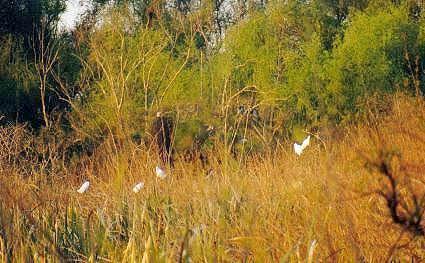 Colony of egrets
nesting in Sarandí (Cephalanthus glabratus - Rubiaceae)
Colony of egrets
nesting in Sarandí (Cephalanthus glabratus - Rubiaceae) |
|
Evidently
we are not alone along this trail...
Here is a curious Gray-necked Woodrail (Aramides cajanea).
Make sure you do not scare it away intentionally. The quieter we
are along the trail the more chances we'll have of seeing this and
other birds that are naturally shy and wary of humans. Just like
on any outing into the wilderness, there are no certainties here.
Unlike visiting a zoo, there is no way to be sure you will see a
particular kind of wild animal. But discovering them in the wild
is so much more rewarding and exciting, even if the full list of
resident species is only partly checked off...
|
|
3
- The Lagoon
|
We've
made it to the quiet lagoon, perhaps the place where you'll see
the most number of birds and maybe also coipus (large rodents) and
tortoises as well. I suggest you stay here for a while, as this
is where things DO happen!
If you see a nice green lawn don't try to walk on it: it's only
floating vegetation (mainly Areaceae: Pistia stratiotes).
On the far side of the lagoon you'll most likely see wild duck,
Jacanas, Gallinules and other herons. Many other bird species are
sure to fly above the lagoon. Among the reeds look out for Plumbeous
Rails, Rufous-sided Crakes and the Curve-billed Reedhaunter, three
species that are a trademark of Ribera Norte! Keep an eye open for
large apple snails, or their bright pink-coloured clumps of eggs
laid on reeds near water. Most importantly: listen for bird calls.
Once heard, look in the direction of the sound. You may be treated
with a "new species"!
|
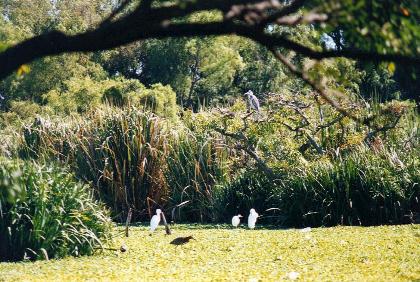 Perched on a
distant ceibo tree is a White-necked Heron. On the floating vegetation
is a lovely Rufescent Tiger-Heron (Tigrisoma lineatum)
Perched on a
distant ceibo tree is a White-necked Heron. On the floating vegetation
is a lovely Rufescent Tiger-Heron (Tigrisoma lineatum) |
4
- Back into the shade
We turn a couple of times and enter a shady "jungle". This
is pretty much a ceibo forest ("ceibal" in Spanish). Lean down
a little to try and spot 2 species of woodrail among the vegetation and
in the swamps.
5 - The metal bridge
|
This
is an important milestone. The bridge spans a muddy section where
the elevated trail has in the past been repeatedly washed away.
Look out for birds crossing underneath and hiding in the thick bushes.
It is also a good vantage point to see the coastline and larger
birds such as lapwings, gulls, raptors and reedbirds. And a nice
place to bask in the sun!
One foggy autumn morning I witnessed a marvellous migration of Fork-tailed
Flycatchers. They were flying up north along the coast, and hidden
by the dense fog, would come into view only 2 or 3 at a time. It
was certainly surreal!
|
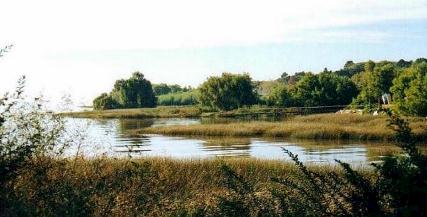 The coast of
the Río de la Plata as seen from the metal bridge
The coast of
the Río de la Plata as seen from the metal bridge |
6
- Riverside bushes
|
We
are now walking parallel to the coast. In some parts here it is
virtually a jungle, and certain bird species are found here more
often, such as the Black-and-rufous Warbling- Finch or the Red-rumped
Warbling-Finch. In summer and autumn I have also seen many rare
butterflies here. A typical plant along this stretch is the Ludwigia
elegans (see photo)
|
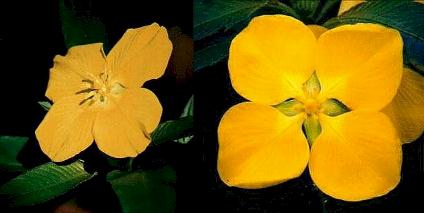 Ludwigia
elegans
Ludwigia
elegans |
7
- Willow forest
We
follow the trail and eventually enter a forest of tall willow trees.
It is the realm of woodpeckers, woodcreepers and other shy birds that
may stay quite high up in the canopy. Listen for the curious "jungle-like"
calls of the Solitary Black Cacique. Wait a moment to see what surprises
lie in store for us today! In summer one of the most beautiful Heliconium
butterflies, with black, red and yellow can be seen flying here -
distinctly amazonian!. In February you may see the largest of them
all: the incredible white Morphos (Morpho epistrophus) that
in flight seems to resemble an A4-sized sheet of paper animated by
some invisible muscle. Photo on the right shoes the Green-barred (previously
Golden-breasted) Woodpecker (Colapets melanolaimus).
|
|
|
8
- Detour to the coast
|
At
the junction we take a short detour to the beach. If the tide is
low we'll see a wide dull-brown sandy beach. Though not at first
visible, some animals live here too, including various freshwater
bivalves introduced from Asia and now thriving. They are potentially-serious
newcomers that are invading the whole of the Parana-Uruguay system.
The negative effects on the native biodiversity will be felt all
the way up to Bolivia. It is to be seen just how serious this will
become. A biological invasion is therefore taking place here and
now, and sadly there is not much that can be done about it other
than witness it from these shores.
One windy day in autumn I noted here a solitary butterfly begin
a feeble and erratic "flutter" above rather unsettled
waters. I followed it with my binoculars as it continued undeterred
away from the shore. It was simply migrating to Uruguay, far beyond
the horizon!
|
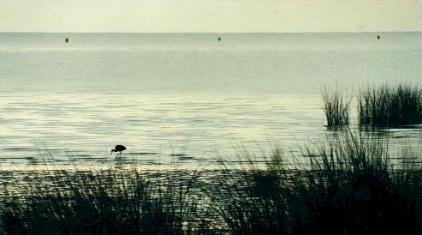 The
photo
shows a Limpkin (Aramus guarauna), possibly feeding on exotic
snails.
The
photo
shows a Limpkin (Aramus guarauna), possibly feeding on exotic
snails. |
9
- Return leg
|
ROAD
CLOSED!
Due
to the rest of the trail being watrerlogged and muddy, it is likely
you will find it closed to the public. For the time being
then, the return path is to go back the way you came. It is a pity
for it means you may miss some nice parts. However, in my experience
I seldom add any new bird species along the section that is now
closed. Once back at the Visitor's Centre find your way to do in
reverse direction the last part of the tail, which should normally
be open. (See Part 12 below)
Appeal: If you are able to contribute funds to the reserve,
it will help to resolve this issue sooner than later. Thank you!
|
|
We're
back on the trail around the reserve and there is still plenty to
explore!
We continue under tall willows and then walk close to the swamps
and over a narrow bridge.
If you are here in September you would be treated to a wonderful
display of Yellow Irises in full bloom. Sadly these are not native
plants but rather are a serious invader that is expanding unchecked
and destroying the native habitats. It is definitely not good news
here! However, many local birds seem to make a home in it: Curve-billed
Reedhaunters, Wren-like Rushbirds, crakes and rails are often seen
in them.
|
|
10
- Aliso forest
|
We
continue along this straight stretch, with reeds on the left and
a drainage ditch on the right. Further to the right is a yachting
club. Look out for turtles resting on some floating plank. Dead
"apple snails" are often found. But how did they arrive
here? Many birds hunt them. Limpkins find them in the swamps and
take them to their favourite perch above the trail to eat the soft
parts inside - and then discard the shell. Woodrails possibly eat
them too.
We soon enter a fairly recent stand of Aliso trees (COMPOSITAE:
Tessaria integrifolia). In the photo the tree in the foreground
is a willow, and behind is the multitude of Alisos, a nice native
tree with purple flowers, that is rapidly expanding. Alisos are
the first trees to grow on new land formations of the Parana river
delta.
|
|
|
Apple
snail
Scientific name:
Pomacea caniculata
It is the favourite food of the Limpkin and a raptor accurately
called the Snail Kite. This fairly large snail lives in freshwater
rivers, lakes and swamps.
|
|
11
- Winding through the reeds
|
We
walk over another small bridge, out of the forest and again have
tall stands of rushes and irises on either side. This is a good
place to note the difference between the plants of Yellow Iris and
the taller native rushes which include Totora (Typha latifolia)
and Cortadera (Scirpus giganteus). We come close to the road
bordering the reserve and then turn left. Here is another beautiful
part with many plants and trees. As we climb to a higher level we
come to a shady spot where you may see the lovely purple flowers
of the Salvia guaranitica. This is often visited by hummingbirds
such as the Glittering-bellied Emerald (Chlorostilbon aureoventris),
which takes little notice of the mechanical device inside the flower
that dabs pollen on its forehead as it inserts its long beak. What
an outstanding adaptation to favour cross-fertilization!
|
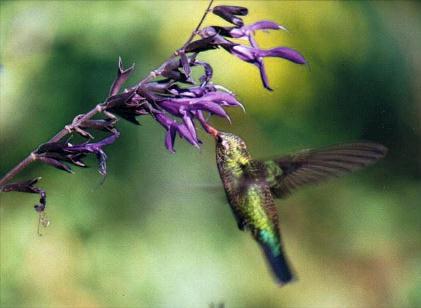 Glittering-bellied Emerald (Chlorostilbon aureoventris)
Glittering-bellied Emerald (Chlorostilbon aureoventris)
feeding from Salvia guaranitica. |
12
- Elevated trail
|
We
now walk along an elevated walkway that runs parallel to the road
outside, made with old Quebracho sleepers recycled from the railway.
Here is another chance to see gallinules, rails, distant herons
or a reedhaunter. This is the spot from which you should be especially
on the lookout for Scarlet-headed Blackbirds, normally seen at a
fair distance. The call is a series of short clear high-pitched
whistles. A sighting of this magnificent bird will certainly be
the unforgettable big prize of the day! And to see it in the wild
is so much nicer than restrained in a cage, where it will soon discolour
and eventually die! It still nests at Ribera Norte, and you may
see it caring for its chicks, as it roams free in the few and small
wild spaces that we humans now allow it to survive in.
|
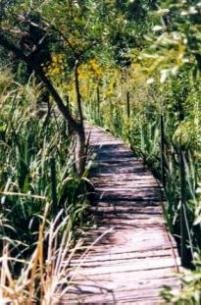 Elevated trail
Elevated trail |
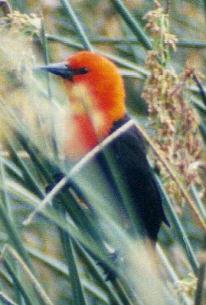 Scarlet-headed
Blackbird
Scarlet-headed
Blackbird |
13
- Back to starting point...
¿Did you like this "virtual walk" then?
OK, so now come and see it with your own eyes. Your visit is certain to
be different in one way or another. It may be a cloudy day, or it could
be quite hot. But you'll be hearing the birds singing. You probably won't
see every bird you were hoping for, but you'll take back many memories
that you cannot experience by simply reading this.
As you leave remember to say "bye" to the warden: he'll like
to know you enjoyed your visit, and will be interested in hearing any
suggestions you might want to make.
If you are able to make any sort of contribution towards the upkeep of
the reserve, you can be sure its inhabitants - the animals and plants
that make it their home - will be forever grateful! It will also contribute
to greatly increase the number of primary-school students that will come
to the reserve to comply with part of their syllabus, most of who have
here their very-first "hands-on" contact with nature. Many of
them are from low-income areas. The Ribera Norte Association provides
trained guides to show them the place and teach them about the importance
of knowing - and conserving - our native plants and animals.
There is a small box near the entrance hut where you can leave your donation.
And if you are able to provide funding for more important projects, then
please contact the Asociación Ribera Norte. Some of the plans that
are on hold - pending adequate funding - are: the construction of a new
trail through the higher land that does not flood and additional development
of the nursery
for native plants.
|